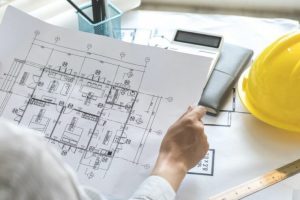 When it comes to construction projects, architectural design plays a crucial role in ensuring the success and functionality of the final structure. It goes beyond just creating a blueprint or drawing; it is a meticulous process that involves careful planning, creativity, and attention to detail. In this article, we will explore why architectural design is essential in construction projects, from ensuring safety and compliance to enhancing aesthetics and functionality.
When it comes to construction projects, architectural design plays a crucial role in ensuring the success and functionality of the final structure. It goes beyond just creating a blueprint or drawing; it is a meticulous process that involves careful planning, creativity, and attention to detail. In this article, we will explore why architectural design is essential in construction projects, from ensuring safety and compliance to enhancing aesthetics and functionality.
Understanding Architectural Design
Architectural design is the process of creating and visualizing the design concept for a building or structure. It involves various stages, including conceptualization, planning, and implementation. The primary goal of architectural design is to create a structure that is not only aesthetically pleasing but also functional, safe, and sustainable. Architects, as professionals in this field, are responsible for translating a client’s vision into a practical design that meets their needs and preferences. They consider factors such as building codes, regulations, site conditions, and budget constraints while designing a structure.
Ensuring Safety and Compliance
One of the most critical aspects of architectural design is ensuring the safety and compliance of the structure. Architects work closely with engineers and other professionals to ensure that the building meets structural integrity requirements and adheres to local building codes and regulations. This includes considerations for fire safety, accessibility, and environmental sustainability. Architectural design also takes into account any potential risks or hazards associated with the site, such as earthquake-prone areas or flood zones. By incorporating safety measures into the design, architects can minimize the risk of accidents or structural failures during and after construction.
Enhancing Aesthetics and Functionality
Architectural design goes beyond just creating a functional structure; it aims to enhance the aesthetics of the building and its surroundings. A well-designed building can have a positive impact on the people who interact with it, creating a sense of awe and inspiration. Architects consider factors such as proportion, scale, materials, and lighting to create visually appealing structures. They also take into account the surrounding environment and cultural context to ensure that the building harmonizes with its surroundings. By incorporating elements of art and design, architects can create structures that are not only functional but also visually striking. Moreover, architectural design focuses on optimizing the functionality and usability of a building. Architects carefully plan the layout, circulation, and spatial organization to ensure that the building meets the needs of its occupants. They consider factors such as natural lighting, ventilation, acoustics, and accessibility to create spaces that are comfortable and efficient.
The Process of Architectural Design
The architectural design process consists of several stages, each with its own set of tasks and deliverables. Let’s explore the typical steps involved in the architectural design process:
Initial Consultation and Project Briefing
The first step in the architectural design process is to have an initial consultation with the client. During this stage, the architect gathers information about the client’s requirements, budget, timeline, and design preferences. This helps the architect understand the scope and vision of the project.
Site Analysis and Feasibility Study
Before proceeding with the design, architects conduct a thorough analysis of the site and its surroundings. They assess factors such as topography, climate, zoning regulations, and existing structures. This helps determine the feasibility of the project and identify any constraints or opportunities.
Conceptual Design
Based on the information gathered from the client and the site analysis, architects develop a conceptual design. This involves creating sketches, drawings, or 3D models to visualize the overall design concept. The conceptual design serves as a starting point for further development.
Design Development
In the design development stage, architects refine the initial concept and develop detailed plans and drawings. They consider factors such as structural systems, materials, and building systems. This stage also involves collaboration with engineers and other specialists to ensure that the design is feasible and meets all technical requirements.
Construction Documentation
Once the design is finalized, architects prepare construction documents that provide detailed instructions for the construction team. These documents include drawings, specifications, and schedules. They serve as a communication tool between the architect and the contractor, ensuring that the project is built according to the design intent.
Bidding and Negotiation
During the bidding and negotiation stage, architects help clients select a contractor for the construction phase. They assist in reviewing bids, evaluating contractor qualifications, and negotiating the contract terms. This ensures that the client gets the best value for their investment.
Construction Administration
Throughout the construction phase, architects provide oversight and guidance to ensure that the project is executed according to the design. They visit the site regularly, review construction progress, and address any issues or changes that arise. Architects act as a liaison between the client and the construction team, ensuring that the design intent is maintained.
The Benefits of Good Architectural Design
Good architectural design offers numerous benefits for both the client and the community. Let’s explore some of the key advantages:
Enhanced User Experience
A well-designed building can significantly enhance the user experience. By considering factors such as natural lighting, ventilation, and spatial organization, architects create spaces that are comfortable, functional, and visually pleasing. Whether it’s a residential home, an office building, or a public facility, good architectural design can positively impact the people who interact with the space.
Increased Property Value
Investing in good architectural design can increase the value of a property. A well-designed building that incorporates quality materials, innovative features, and sustainable design principles is more likely to attract buyers or tenants. It can also contribute to the overall aesthetic appeal of a neighborhood or community, further boosting property values.
Energy Efficiency and Sustainability
Architects play a crucial role in promoting energy efficiency and sustainability in the built environment. Through thoughtful design and the use of sustainable materials and technologies, architects can reduce a building’s energy consumption and environmental impact. This not only benefits the environment but also helps clients save on energy costs in the long run.
Cultural and Community Impact
Architecture has the power to shape and reflect a community’s identity and culture. By incorporating elements of local history, traditions, and aesthetics, architects can create buildings that contribute to a sense of place and community pride. Architectural landmarks and iconic structures can become symbols of a city or region, attracting visitors and boosting tourism.
Economic Development
Well-designed buildings and public spaces can have a significant impact on local economies. Architectural design can attract businesses, investors, and tourists, stimulating economic growth and development. Vibrant and well-designed urban areas can become hubs for innovation, creativity, and entrepreneurship.
The Future of Architectural Design
As technology advances and societal needs evolve, the future of architectural design holds great potential for innovation and creativity. Here are some trends and developments that are shaping the future of this field:
Sustainable Design Practices
With a growing focus on sustainability and environmental responsibility, architects are increasingly incorporating sustainable design practices into their projects. This includes using renewable materials, implementing energy-efficient systems, and designing for resilience and adaptability.
Smart Buildings and Technology Integration
Advancements in technology are revolutionizing the way buildings are designed and operated. The integration of smart technologies, such as IoT devices, sensors, and automation systems, allows for enhanced functionality, energy efficiency, and occupant comfort. Architects are exploring ways to incorporate these technologies seamlessly into their designs.
Biophilic Design
Biophilic design is an approach that seeks to connect people with nature through the built environment. It involves incorporating natural elements, such as plants, natural light, and views of nature, into the design of buildings. Biophilic design has been shown to improve well-being, productivity, and overall satisfaction.
Adaptive Reuse and Retrofitting
As sustainability becomes a priority, adaptive reuse and retrofitting are gaining traction in architectural design. Rather than demolishing old structures, architects are finding ways to repurpose and transform existing buildings. This not only reduces wastage but also preserves historical and cultural heritage.
Parametric Design and Generative Algorithms
Parametric design and generative algorithms allow architects to explore complex design possibilities and optimize building performance. These tools enable architects to create innovative forms, optimize energy efficiency, and generate design variations quickly. They are revolutionizing the design process and pushing the boundaries of architectural creativity.
We Provide General Commercial Contracting Services
We oversee construction projects from the beginning to the end. This includes designing, planning, building, and managing the entire process. We are responsible for coordinating with architects, engineers, and other subcontractors to ensure that the project is completed within the set timeline and budget.
> Learn More
Architectural design is a vital aspect of construction projects. It ensures safety, functionality, and aesthetic appeal while considering the needs of clients and the surrounding environment. Architects play a crucial role in translating ideas into practical designs that meet the highest standards of quality and sustainability. As technology advances and societal values evolve, the future of architectural design holds great promise for innovative and transformative buildings that enhance our lives and communities.
Contact us (513-617-1401) for more information or a quote
—

About ABS Services
ABS Services provides comprehensive commercial construction services to Greater Cincinnati, Northern Kentucky, and Southeast Indiana. We have the experience, equipment, and the right team to get the job done!
> Learn More
